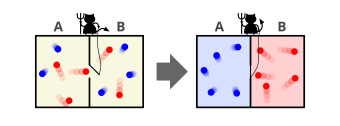
Maxwell's demon is a thought experiment that appears to disprove the second law of thermodynamics. It was proposed by the physicist James Clerk Maxwell in 1867.[1] In his first letter, Maxwell referred to the entity as a "finite being" or a "being who can play a game of skill with the molecules". Lord Kelvin would later call it a "demon".[2]
In the thought experiment, a demon controls a door between two chambers containing gas. As individual gas molecules (or atoms) approach the door, the demon quickly opens and closes the door to allow only fast-moving molecules to pass through in one direction, and only slow-moving molecules to pass through in the other. Because the kinetic temperature of a gas depends on the velocities of its constituent molecules, the demon's actions cause one chamber to warm up and the other to cool down. This would decrease the total entropy of the system, seemingly without applying any work, thereby violating the second law of thermodynamics.
The concept of Maxwell's demon has provoked substantial debate in the philosophy of science and theoretical physics, which continues to the present day. It stimulated work on the relationship between thermodynamics and information theory. Most scientists argue that, on theoretical grounds, no practical device can violate the second law in this way. Other researchers have implemented forms of Maxwell's demon in experiments, though they all differ from the thought experiment to some extent and none has been shown to violate the second law.
- ^ Cargill Gilston Knott (1911). "Quote from undated letter from Maxwell to Tait". Life and Scientific Work of Peter Guthrie Tait. Cambridge University Press. pp. 213–215.
- ^ Cite error: The named reference
Aiv9Swas invoked but never defined (see the help page).